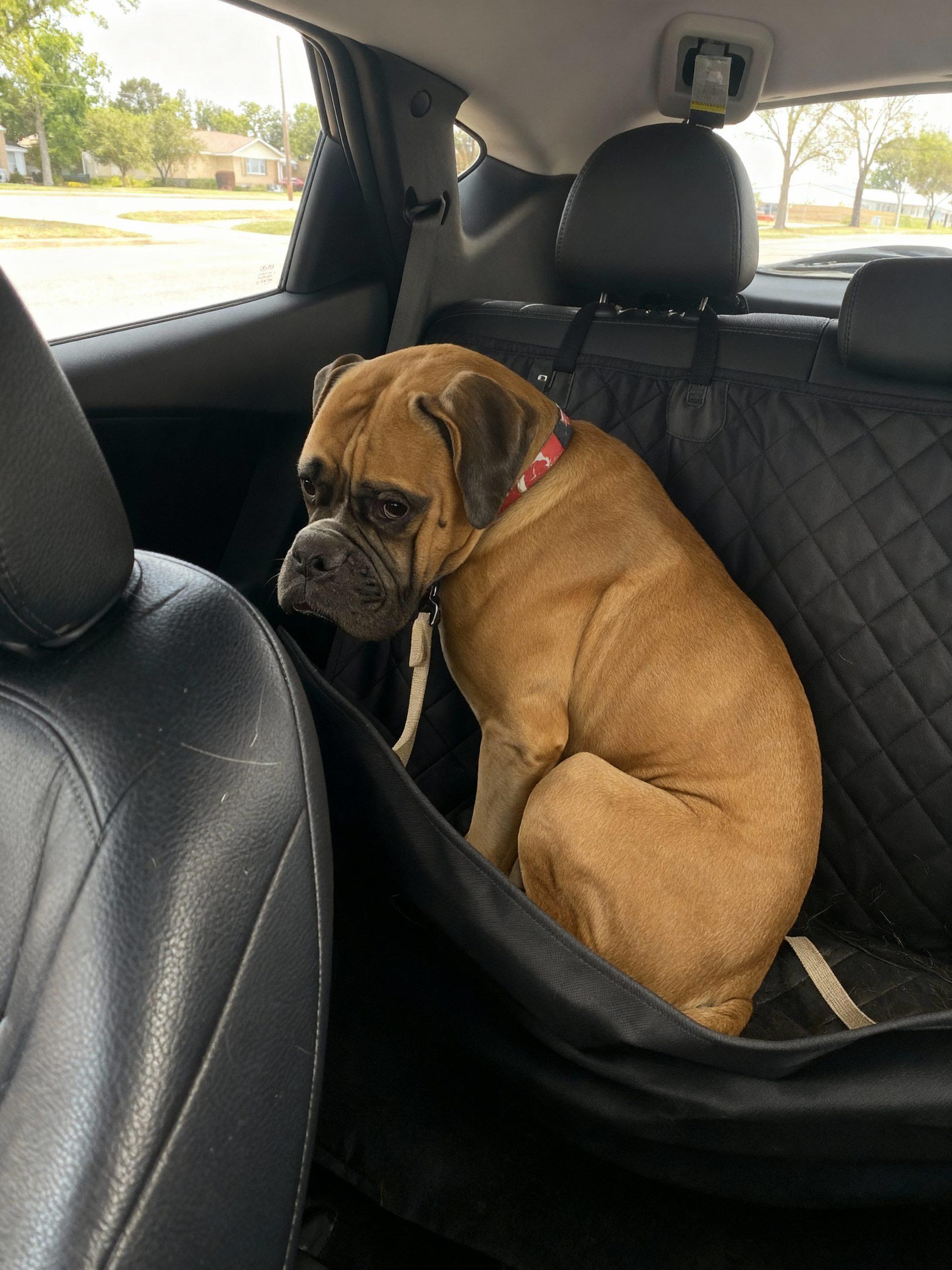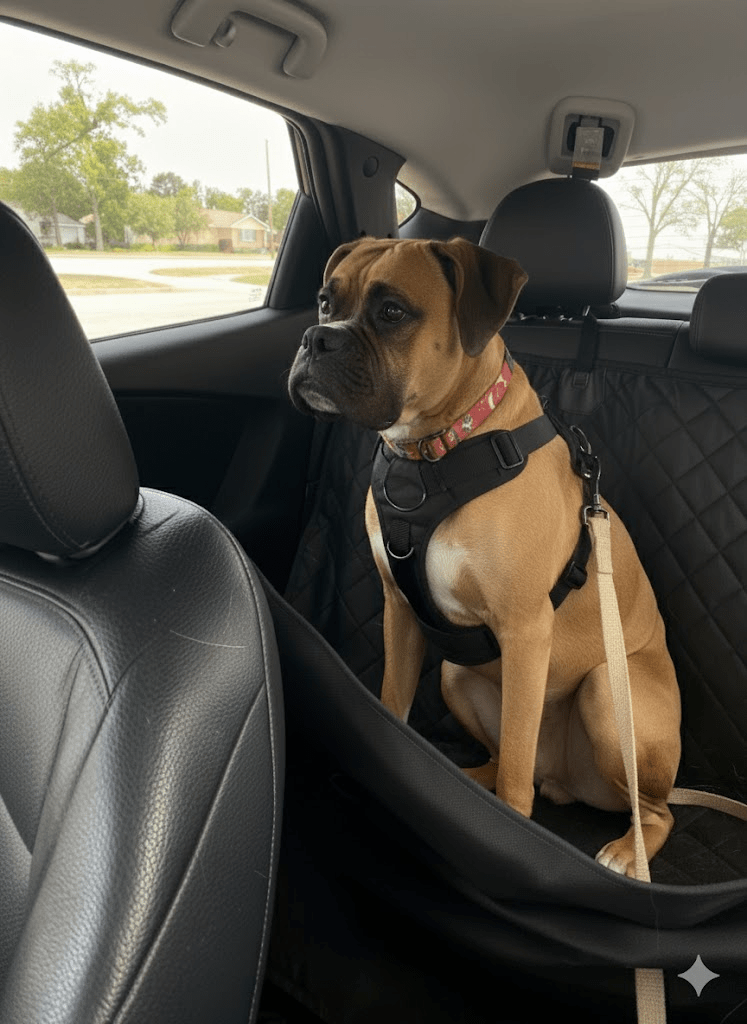The image of a sturdy Boxer curled up in the back of a car, body tense and eyes weary, tells a profound story that extends far beyond a simple car ride. This dog, strong in build but clearly bearing the invisible scars of a troubled past—one marked by neglect, fear, and punishment—is unknowingly embarking on the most crucial journey of his life: the trip to his forever home. For countless dogs like him, who have known the pain of a cruel hand, the loneliness of a chain, and the constant anxiety of an unsafe existence, the concept of a gentle touch, a full meal, or a safe place to rest is utterly foreign. His flinching response to kindness is not defiance; it is a primal, learned reaction—a memory of when a hand reaching out meant impending harm. He does not yet know the significance of the shift from a life of survival to one of security, but the person driving knows. This journey is a powerful testament to the compassion required to heal a broken spirit and serves as a vital lesson in the patience, understanding, and unwavering commitment needed to save a rescue dog.

The Psychological Landscape of a Rescue Dog
A dog rescued from chronic abuse or severe neglect carries more than just physical ailments; they carry psychological trauma. This trauma fundamentally alters their perception of the world and their ability to trust. When an animal lives in a state of constant high alert, their nervous system is rewired to prioritize survival over everything else. Behaviors that seem problematic to a new owner—such as fear-based aggression, resource guarding, or hyper-vigilance—are often direct coping mechanisms developed during their previous life. For the Boxer in the image, every sound is a potential threat, and every human movement must be scrutinized. His current state of tension is not a sign of a bad personality; it’s a symptom of Post-Traumatic Stress. To effectively help a dog like this, one must move beyond traditional obedience training and focus on healing the underlying anxiety and rebuilding a shattered sense of safety. Understanding this psychological backdrop is the first step toward effective rehabilitation.

The Critical Role of Patience and Predictability
Healing from trauma is not a linear process, and for a rescue dog, it requires an environment of absolute predictability and patience. The new home must become a safe haven, a place where the dog can learn that good things happen consistently and that bad things never will. This means establishing a routine that is rigid in its consistency: feeding times, walks, and rest periods must occur at the same time every day. This structure provides a psychological framework that gradually replaces chaos with order, allowing the dog’s nervous system to finally relax. The human’s role is not to demand immediate affection or obedience but to simply be a reliable presence. The initial interaction should focus on non-threatening activities, such as sitting quietly in the same room, tossing a treat gently from a distance, or offering a soft blanket. Every positive, low-key interaction chips away at the wall of fear the dog has built around its heart. The person driving the Boxer understands this; she isn’t looking for a pet to “own,” but a life to “save,” knowing that the reward—the moment the dog finally lets its guard down—will take time, perhaps months, but will be worth the wait.

Relearning Trust: The Gentle Hand
The most significant hurdle for a previously abused dog is relearning what a human hand means. For the Boxer, a hand was an instrument of pain or control. Therefore, the simple act of a gentle pet is a monumental step in the trust-building process. This must be approached with extreme caution and sensitivity. Initial touch should be offered indirectly and on the dog’s terms. Starting with a gentle, slow movement toward a neutral area like the dog’s chest or shoulder, rather than the sensitive head, allows the dog to maintain a sense of control. If the dog flinches, recoils, or shows signs of stress, the human must immediately withdraw and provide space, never forcing the interaction. This demonstrates a respect for the dog’s boundaries and teaches him that he is finally safe and has a voice in his environment. Over time, the dog learns that the hand provides comfort, not consequence. The leather collar mentioned in the caption is a symbol of this shift—it’s not a tool for confinement, but a necessary accessory for care and protection on walks, signaling the new life of safety under the careful watch of his rescuer.

The Power of Play and Enrichment
As a dog begins to decompress in their new home, introducing play and environmental enrichment becomes critical for their mental well-being. Play is a key way for a dog to safely express their natural energy, build confidence, and deepen the bond with their human. For a Boxer, a breed known for its boundless energy and “clownish” nature, the ability to run freely in a yard, chase a favorite ball, or chew on a durable toy is essential to reclaiming their spirit. The Boxer described in the narrative, who was once chained and silenced, will soon discover the joy of running at full speed with the wind in his ears. This freedom is more than just exercise; it’s a therapeutic release from past confinement and stress. Enrichment activities, such as puzzle feeders or engaging chew toys, redirect focus from anxiety to problem-solving, helping to rebuild the dog’s self-esteem and providing a positive outlet for their intelligence. These simple tools are crucial in the transformation from a “guard dog” who knew only pain to a cherished family member who knows only love.
The Quiet Victory: Love Replacing Fear
The ultimate goal of this journey—the rescue, the patience, the rebuilding of trust—is to witness the quiet moment when love finally replaces fear. This transformation is rarely dramatic. It manifests in small, yet profound, shifts: the moment the dog finally falls asleep with a deep sigh, belly full and unprotected; the choice to rest his head on the human’s foot instead of in a far corner; or the first time his tail offers a tentative, loose wag upon seeing his person. The final lines of the narrative capture this victory beautifully: the dog will eventually realize that the soft voice he hears doesn’t mean danger, that his strong chest can finally rise with peace, and that he’s no longer just a dog, but a Boxer who is finally loved. This journey is a two-way street; while the human saves the dog, the dog’s resilience and eventual trust offer the human a powerful reminder of the profound impact of simple, unwavering kindness. He may not know it yet, but he is about to receive a name, a home, a family, and a heart that will beat for him, forever. His life of loneliness is over.






